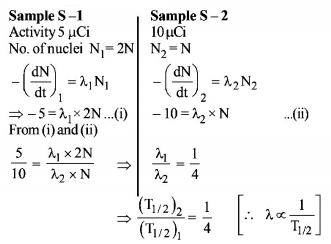1. The energy equivalent of one atomic mass unit is
A.
$$1.6 \times {10^{ - 19}}J$$
B.
$$6.02 \times {10^{23}}J$$
C.
$$931\;MeV$$
D.
$$9.31\,MeV$$
Answer :
$$931\;MeV$$
2. The half-life of radium is about $$1600\,yr.$$ Of $$100\,g$$ of radium existing now, $$25\,g$$ will remain unchanged after
A.
$$4800\,yr$$
B.
$$6400\,yr$$
C.
$$2400\,yr$$
D.
$$3200\,yr$$
Answer :
$$3200\,yr$$
3. The ratio of the radii of the nuclei $$_{13}A{l^{27}}$$ and $$_{52}T{e^{125}}$$ is approximately
A.
$$6:10$$
B.
$$13:52$$
C.
$$40:177$$
D.
$$14:73$$
Answer :
$$6:10$$
4.
Calculate binding energy of $$_{92}{U^{238}}.$$
Given $$M\left( {{U^{238}}} \right) = 238.050783\,amu,{m_n} = 1.008665\,amu$$ and $${m_P} = 1.007825\,amu$$
A.
$$801.7\,MeV$$
B.
$$18.7\,MeV$$
C.
$$0.7\,MeV$$
D.
$$1801.7\,MeV$$
Answer :
$$1801.7\,MeV$$
5. When $$_3L{i^7}$$ nuclei are bombarded by protons, and the resultant nuclei are $$_4B{e^8},$$ the emitted particles will be
A.
alpha particles
B.
beta particles
C.
gamma photons
D.
neutrons
Answer :
gamma photons
6. A radioactive sample $${S_1}$$ having an activity $$5\mu Ci$$ has twice the number of nuclei as another sample $${S_2}$$ which has an activity of $$10\,\mu Ci.$$ The half lives of $${S_1}$$ and $${S_2}$$ can be
A.
20 years and 5 years, respectively
B.
20 years and 10 years, respectively
C.
10 years each
D.
5 years each
Answer :
20 years and 5 years, respectively
7. The electron emitted in beta radiation originates from
A.
inner orbits of atoms
B.
free electrons existing in nuclei
C.
decay of a neutron in a nucleus
D.
photon escaping from the nucleus
Answer :
decay of a neutron in a nucleus
8. A radioactive substance with decay constant of $$0.5\,{s^{ - 1}}$$ is being produced at a constant rate of $$50$$ nuclei per second. If there are no nuclei present initially, the time (in second) after which $$25$$ nuclei will be present is
A.
$$1$$
B.
$$\ln 2$$
C.
$$\ln \left( {\frac{4}{3}} \right)$$
D.
$$2\ln \left( {\frac{4}{3}} \right)$$
Answer :
$$2\ln \left( {\frac{4}{3}} \right)$$
9. A radioactive isotope has a half life of 100 years. How long will it take the activity to reduce to $$1\% $$ of its original valve?
A.
330 years
B.
460 years
C.
660 years
D.
920 years
Answer :
660 years
10. Half-life of a radioactive substance is $$12.5\,h$$ and its mass is $$256\,g.$$ After what time, the amount of remaining substance is $$1g$$ ?
A.
$$75\,h$$
B.
$$100\,h$$
C.
$$125\,h$$
D.
$$150\,h$$
Answer :
$$100\,h$$
